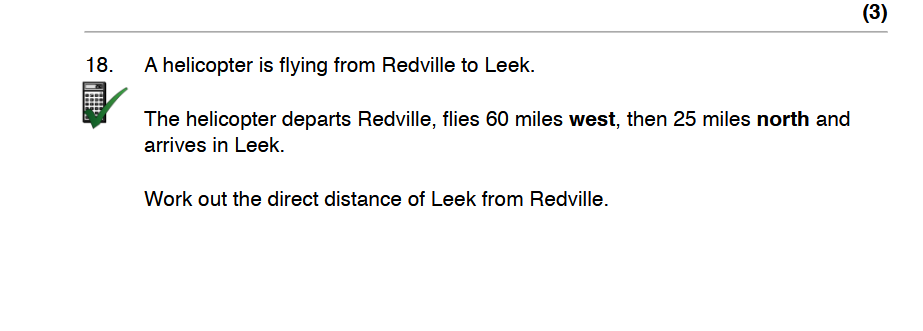A helicopter is flying from Redville to Leek. The helicopter departs Redville, flies 60 miles west, then 25 miles north and arrives in Leek. Work out the direct distance of Leek fr... A helicopter is flying from Redville to Leek. The helicopter departs Redville, flies 60 miles west, then 25 miles north and arrives in Leek. Work out the direct distance of Leek from Redville.

Understand the Problem
The question is asking us to calculate the direct distance from Redville to Leek after the helicopter has traveled 60 miles west and then 25 miles north. This requires using the Pythagorean theorem to find the hypotenuse of the right triangle formed by these two legs of the journey.
Answer
The direct distance from Redville to Leek is $65$ miles.
Answer for screen readers
The direct distance from Redville to Leek is $65$ miles.
Steps to Solve
- Identify the triangle sides
The helicopter flies 60 miles west and then 25 miles north. This creates a right triangle where the legs are $60$ miles and $25$ miles.
- Apply the Pythagorean theorem
The Pythagorean theorem states that in a right triangle, the square of the hypotenuse ($c$) is equal to the sum of the squares of the other two sides ($a$ and $b$):
$$ c^2 = a^2 + b^2 $$
In this case, let $a = 60$ miles and $b = 25$ miles.
- Calculate the hypotenuse
Substituting the values into the equation:
$$ c^2 = 60^2 + 25^2 $$
Calculating the squares:
$$ c^2 = 3600 + 625 $$
Now add them together:
$$ c^2 = 4225 $$
- Find the length of the hypotenuse
To find $c$, take the square root of $c^2$:
$$ c = \sqrt{4225} $$
Now, calculate the square root:
$$ c = 65 $$
The direct distance from Redville to Leek is $65$ miles.
More Information
The Pythagorean theorem is a fundamental principle in geometry that relates the lengths of the sides of right triangles. This problem illustrates its application in real-world scenarios, such as calculating distances.
Tips
- Forgetting to square the lengths: Make sure to square each leg of the triangle before summing them.
- Incorrectly applying the Pythagorean theorem: Remember that the theorem only applies to right triangles.
- Not taking the square root of the sum: Ensure to calculate the hypotenuse by taking the square root of the sum of the squares.
AI-generated content may contain errors. Please verify critical information